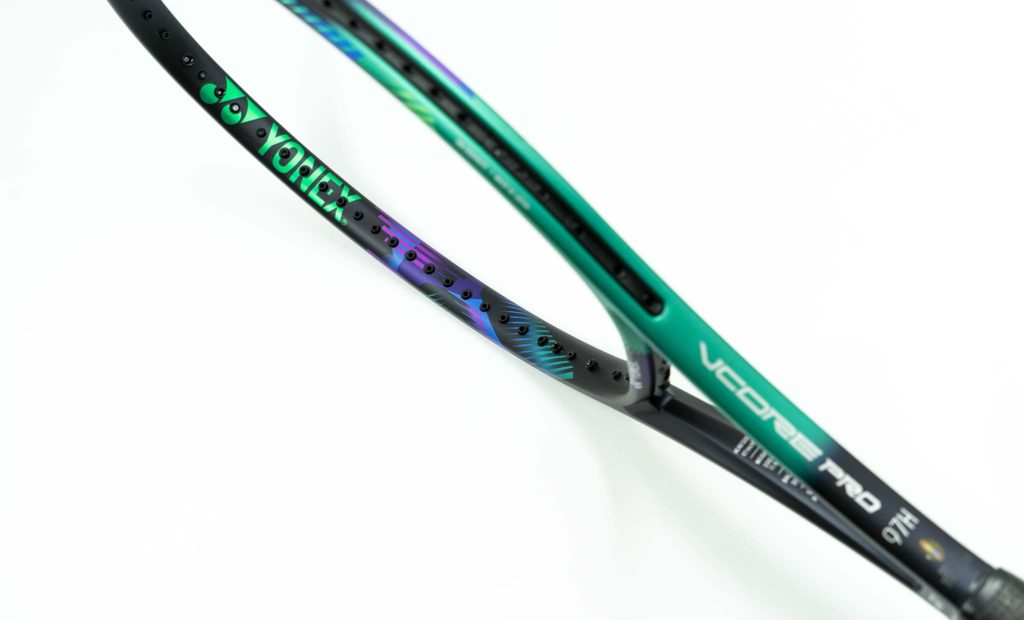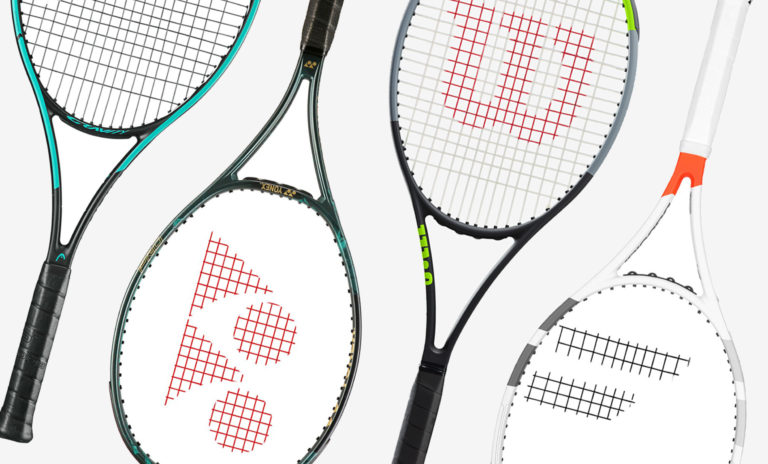The heaviest racket in the Yonex lineup, the Vcore Pro 97H is a real weapon in the hands of someone that can wield it. In fact, it’s one of our favourite rackets on the market so we’ve put together an in-depth Yonex Vcore Pro 97H review to tell you exactly why we love it!
We may earn an affiliate commission from links on this page. Tennis Creative does not accept money for editorial gear reviews, so we only recommend products we love!
Yonex Vcore Pro 97H 330g Specs
| Length | 27 inch / 68.58 cm |
| Head Size | 97 in² / 625.81 cm² |
| String Pattern | 16 Mains / 19 Crosses |
| Unstrung Weight | 11.6 oz / 330 g |
| Strung Weight | 12.3 oz / 349 g |
| Strung Balance | 7 pts HL / 320 cm |
| Composition | HM Graphite / 2G-NAMD |
| Beam Width | 21mm / 21mm / 21mm |
| Swingweight | 337 |
| Stiffness | 61 RA |
| String Tension | 45-60 pounds |
Vcore Pro 97 H Design & Aesthetics


Appearance
Let’s start with the racket’s appearance and it’s safe to say the Vcore Pro 97H is a thing of beauty. Combining metallic green, blue and purple, the racket’s paint job gives it an ultra-modern look that we absolutely love.
Isometric Technology
Yonex’s Isometric technology has been the brand’s most unique feature for over 30 years and involves using a square-shaped or Isometric frame that results in a 7% larger sweetspot when compared to conventional tennis rackets. It’s the reason for the unique shape of Yonex’s rackets, and while it may take a bit of getting used to, it can be a real game changer.
Vibration Dampening Mesh (VDM)
The Vcore Pro 97H makes use of Yonex’s VDM technology, which involves wrapping a stretchy mesh material around the graphite in the racket handle. The purpose of it, as the name suggests, is to reduce any unwanted vibrations and in the process increase the overall touch and feel of the racket frame.
FlexCon & Flex Fuse Systems
The Vcore Pro 97H uses a combination of what Yonex call Flex Force and Flex Fuse graphite in the throat of the racket including a shock-absorbing polymer within the graphite’s resin. This increases the racket’s flexibility and adds a softer and more plush feeling.
2G-Namd Flex Force
Incorporating 2G-Namd Flex Force graphite in the upper throat and lower frame of the racket, the Vcore range of rackets is designed to quickly flex and snap back increasing the racket’s flexibility and spin potential.
Our Racquet Testing Setup
We tested the Vcore Pro 97H over several weeks using a full bed of MSV Focus Hex polyester strings strung at three different tensions: high (58 lbs), medium (53 lbs) and low (48 lbs).
Overall Test Results - Yonex Vcore Pro 97 H
Here’s a quick overview of the ratings we awarded the racquet in our test:
Groundstrokes - Score: 86
From the baseline, the Vcore Pro 97 is a real weapon. The insane 337 swingweight can be enough to put some players off. However, if you can handle it, it offers incredible amounts of power from the back of the court. Combined with a very flexible and 7 pts Head Light design, it also offers lots of control. The new spin technologies and the open 16×19 string pattern helped produce plenty of spin and the result is a frame that offers a rare yet beautiful blend of power and control on groundstrokes.
This generation of Vcore Pro racket’s features a slightly thicker beam width compared to the previous generation and it just adds a little more stability to the frame, making it feel like a more solid racket overall. It’s particularly noticeable on groundstrokes where we felt the previous generation racket seemed somewhat unstable when hitting with large amounts of topspin. This version however offers plenty of spin potential while still keeping a steady frame.
As for testing the racket at different string tensions, we found that the racket felt a little underpowered when strung at 58 lbs, though that will of course depend on each player. At 48 lbs, we felt it played nicely at first but became somewhat difficult to handle once the string tension dropped. We’d say that the racket performed best when strung at around 53 lbs and only seemed to get better as the tension dropped.
Overall, we find it to be a very pleasant racket to rally with as we never really felt the ball sail past the baseline, even when unleashing on a huge forehand down the line. We got plenty of bite on our topspin shots and even had a lot of feel on the backhand slice and dropshots.
Volleys - Score: 87
At the net, the Vcore Pro 97H performs exceptionally well. It can be a little difficult to manoeuvre at times despite the 7 pts Head Light balance, particularly when trying to hit quick reaction volleys. It’s less of a problem in singles, but we noticed it was a slight bit more of a problem in doubles when we were under more pressure at the net.
That being said, it’s fantastic when in the hands of the right volleyer. The combination of power, control and stability in a rock solid frame makes volleying extremely comfortable and can even make putting away a volley seem easy, while still offering plenty of feel for drop volleys.
Serves - Score: 87
On serve, this racket is can make or break your game. It is a difficult racket to swing and that becomes very apparent on serve. If you struggle with racket head speed, particularly on serve, you’ll find it difficult generate much power or spin on serve with the Vcore Pro 97H.
Personally though, we loved it as the huge swingweight offered one heck of a punch on big flat serves. We were also able to generate enough spin to get a real bite on slice serves and a pretty big kick on topspin serves.
Returns - Score: 84
Again, the racket can be difficult to swing and it can be a problem when facing down serves. Anyone struggling to wield it will have trouble getting the racket into position on return.
However, we found the racket to be great to return serves with, particularly when blocking serves or chipping them back into play. Thanks to it’s control oriented and rock-solid design, the Vcore Pro 97H is great at soaking up the power on huge serves and really helps keeping the ball in the court. Given the racket’s weight, swinging at returns can be a little more challenging, but it can also help send the serves back with interest.
FAQs About the Vcore Pro 97H
Who uses the Yonex Vcore Pro 97?
The Vcore Pro 97 is the racket of choice of several pro players on the men’s tour including Stan Wawrinka, Hubert Hurkacz, Frances Tiafoe and Pierre Hughes Herbert.
Which is better Yonex Vcore or Ezone?
It depends. Both racket ranges offer different advantages and disadvantages. The Vcore rackets are designed for control and suit players with full-swings that are able to generate lots of power themselves, while the Ezone rackets are better suited to players looking to add more power and spin to their game.
Yonex Vcore Pro 97 vs Ezone 98
The Vcore Pro 97 is often compared to other rackets in the Yonex lineup, one of them being the Ezone 98. While both rackets use many of the same technologies, they’re very different both in specs and their features. The Vcore Pro 97H is a racket very much designed for control, while the Ezone 98 is designed for spin and easy access to power.
Compared To Other Rackets
When comparing the Vcore Pro 97H to other rackets we’ve tested, we’d probably say it’s similar in many ways to the Wilson Pro Staff RF97. They both have the same head size and string patterns as well as a very similar frame weight. However, the biggest difference between the two is the frame stiffness. The Vcore Pro 97H offers a much more flexible frame design that’s more arm-friendly than the RF97.
Overall Score: 87
Overall, we loved the Vcore Pro 97H. It’s definitely one of the best rackets on the market for advanced players and offers a beautiful combination of control and power, all in a very comfortable and arm-friendly frame.
Pros:
- Control
- Power
- Stability
- Arm-friendly
Cons:
- Not suitable for beginners
- Very Heavy
- Difficult to manoeuvre

Hopefully that give’s you a better idea of what this racket is really like. That being said, if you have any questions at all or have already played with it, be sure to let us know your thoughts in the comments below.





